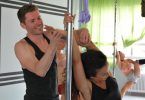Scoliosis doesn’t mean giving up on movement and expression. If you’ve ever wondered, “Can I dance with scoliosis?”—the answer is YES! With proper guidance and modifications, pole dancing can be an empowering and fulfilling experience for those with scoliosis.
What Is Scoliosis and Can I Dance with Scoliosis?
Scoliosis is a condition where the spine curves abnormally to the side. This curvature can range from mild to severe; some people might not even experience pain. However, scoliosis can affect flexibility, balance, and posture.
- Mild cases may not require modifications, while severe scoliosis may need adjustments.
- Understanding your specific curve pattern will help you adapt movements safely.
- Consulting a doctor or physical therapist ensures you know your limitations and safe movement patterns.
Remember: Every scoliosis case is unique, so learning how your spine reacts to movement is key!
How to Approach Pole Dancing with Scoliosis
Pole dancing requires flexibility, strength, and balance—all of which can be affected by scoliosis. Here’s how to make it work for you:
1. Strengthen Your Core
A strong core improves stability and reduces pressure on the spine. Focus on:
- Planks (modified if needed)
- Bridges for glute activation
- Dead bugs for core engagement
2. Modify Pole Dancing Moves
Not all pole moves are scoliosis-friendly. Work with an instructor to adjust techniques to fit your abilities.
3. Listen to Your Body
- Avoid excessive backbends if they cause discomfort.
- Engage both sides of your body to prevent imbalance.
- Stop if you feel pain—pole dancing should be challenging but not painful.
Pole Dancing with Scoliosis: Safe vs. Risky Moves
A comparison table can help highlight which moves are safe and which to modify or avoid.
| Move Type | Safe Moves | Moves to Modify or Avoid |
|---|---|---|
| Climbs | Basic climbs using both sides | Uneven climbs that stress one side |
| Spins | Chair spin, fireman spin | Twisting spins (require core control) |
| Inverts | Basic inverted tuck (if strong enough) | Deep backbends or uncontrolled inverts |
| Floor Work | Leg waves, hip circles | Moves requiring extreme lumbar extension |
| Strength Moves | Pole sits, plank holds | Moves with heavy upper back arching |
Tip: Always warm up and practice under a certified instructor who understands scoliosis modifications.
Key Safety Tips for Dancing with Scoliosis
Here’s how to enjoy pole dancing safely and effectively:
Find the Right Instructor
- Look for an instructor experienced with scoliosis.
- Consider private lessons to get customized guidance.
- Try online pole dance courses if you prefer a flexible learning environment.
Check out Open Dance Academy for beginner-friendly pole dance classes!
Warm-Up and Cool Down Are Non-Negotiable
Always include:
- Dynamic stretching before practice
- Foam rolling to release tension
- Gentle spinal mobility work to prepare your back
Choose the Right Pole
Ensure your pole is:
- Securely installed for stability
- Grip-friendly to prevent excessive muscle strain
- Adjustable for different moves
Consult Your Doctor
Your doctor or physiotherapist should be part of your journey. Discuss:
- Which movements to avoid
- If physical therapy could help strengthen key muscles
- Long-term impact of pole dancing on your spinal health
Beyond Limitations: The Empowering Journey of Pole Dancing with Scoliosis
Pole dancing isn’t just about physical movement—it’s about self-confidence, strength, and resilience.
- Body Awareness: You’ll learn to move in ways that complement your scoliosis.
- Building Strength: Each pole session strengthens your core, back, and overall posture.
- A Supportive Community: The pole dancing world is inclusive and encouraging—embrace the journey!
FAQs: Can I Dance with Scoliosis?
1. Is pole dancing safe for people with scoliosis?
Yes, but it depends on the severity of your condition. Always consult a doctor or instructor for personalized advice.
2. What should I do if certain moves hurt my back?
Modify or skip moves that feel uncomfortable. Your instructor can suggest safe alternatives.
3. How can I build confidence as a pole dancer with scoliosis?
- Focus on your personal progress rather than comparisons.
- Surround yourself with a supportive community.
- Choose modifications that empower your movement, rather than avoiding challenges.
Final Thoughts: Yes, You Can Dance with Scoliosis!
Scoliosis doesn’t define your limits—it shapes your strength. With the right approach, pole dancing can be an empowering and fulfilling journey.
Ready to start your pole dance journey? Join an inclusive class, consult with an expert, and explore modifications that work for you.
Share your experience! Comment below—your journey may inspire others with scoliosis to embrace movement confidently!







